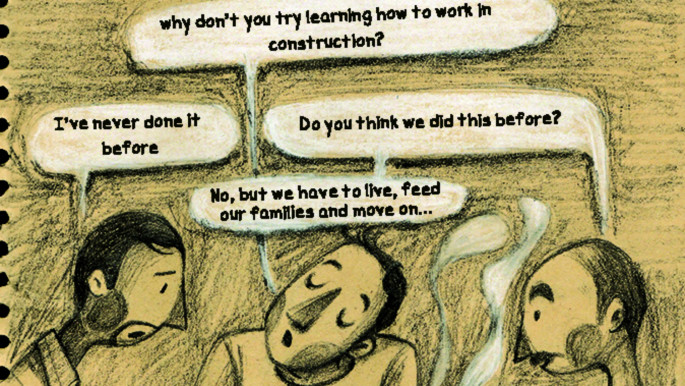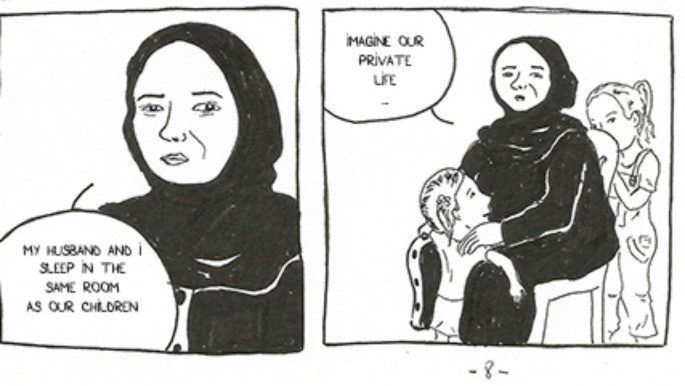Comic artists draw attention to Syrian refugees in Lebanon
"Meantime", the name given to the collection by French NGO Solidarites International (SI), produced in partnership with the EU and UNICEF, is available online in English, Arabic and French.
The New Arab spoke to the lead instigator of the project, which saw five different artists spend weeks speaking to refugees in north Lebanon.
Pauline Gregoire, SI's communication officer in Lebanon, said the idea was motivated by a desire to reach out to people in Europe and elsewhere to raise awareness about the living conditions of Syrian refugees.
"I really wanted to do something original, something that people can relate to and can interest them" without thinking it is an advert for an NGO, Gregoire told The New Arab.
"With graphic novels, people can relate to characters a lot more and they can get into the story quickly" she said.
To create the novels, five different cartoon artists were chosen to give their own unique view on the realities of refugee life.
 |
| Each artist tackled the daily issues faced by the refugees [Diala Brisly] |
"I felt that working with different artists can bring different outlooks to each story," Gregoire said, "Each artist tackled the daily issues faced by the refugees, such as access to shelter, water, food, medical supplies and so on."
The comic "Goings-on in Lebanon" was created by Lisa Mandel. An award-winning French-comic artist who had previously spent time with migrants in Calais, Mandel in her piece seeks to depict the status and overall context of refugee life in the country.
In "Where there is life, there is love" Lebanese artist Lena Merhej tells of the life and hopes of Syrian refugees living in tents through the eyes of her characters Abu Khaled, Fawzia and Najwa.
Merhej, who teaches at the Lebanese International University and has had work exhibited both in Lebanon and internationally, had earlier tackled the vagaries of life in the Lebanese civil-war.
The grind and daily obstacles faced by 58 refugee families who have lived in a tower block for the past 4 years are subject of Lebanese artist Kamal Hakim's Aassoun Tower. Like Merhej, Hakim had too treated in an earlier graphic novel the Lebenase civil-war.
 |
The comic strip idea was motivated by a desire to reach out to people in Europe to raise awareness about the living conditions of Syrian refugees |  |
The struggle for survival in the narrow streets of Tripoli and hopes for a new start are subject of "The Visitor in Exile" by Lebanese artist Nour Hifaoui Fakhoury, a graduate of the Lebanese School of Fine Arts.
The comic "Our life in a Tent" was conceived by Syrian cartoonist Daila Brisly, who herself had to leave Syria for Turkey in 2013 before coming to Lebanon. Brisly narrates a fictional story based on the excruciating search for employment forced on Syrians who had to leave at a moments’ notice.
"Diala chose to portray the difficulties a family goes through and how being a refugee changes and shapes family life," Gregoire told The New Arab.
"There is a focus on the impact being refugee has on men, because – in the context of Lebanon – Syrian refugee men are more often arrested at check points than women. So as a result, women are sometimes having to go out to work and provide for the family," Gregoire said.
"Diala really wanted to focus on how a man can be pressurised and broken down by this situation, and how it is important to take the man’s opinion in these situations," Gregoire added.
 |
| The graphic novels depict daily struggles of Syrian refugees in Lebanon [Nour Hifaoui Fakhoury] |
Above all for Gregoire, the novels seek to depict the struggles of Syrian refugees as well as highlight the small details that make up their daily life.
"It is about how to keep living when you are a refugee really. I asked the artists to pay attention to show solidarity with these people," Gregoire said, "To tell stories about everything that makes their daily lives a struggle - from when they first arrive, to how they sleep, how they wash and so on."
For the time being the graphic novels are only available online but the NGO hopes to publish print editions in the near future.
"We are hoping to produce a more complete series soon, which can then be printed and available in stores," Gregoire said.
Since the conflict in Syria began in 2011, more than 1.5 million Syrians fled their country seeking refuge in neighbouring Lebanon.
Most of them settled around the Syrian border in Northern Lebanon well as the Bekaa valley in the eastern part of the country – areas that are already considered underdeveloped and neglected by the Lebanese government.





 Follow the Middle East's top stories in English at The New Arab on Google News
Follow the Middle East's top stories in English at The New Arab on Google News


